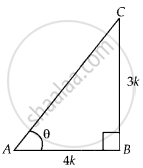Advertisements
Advertisements
Question
Prove the following:
If tan A = `3/4`, then sinA cosA = `12/25`
Solution

Given, tan A = `3/4 = "P"/"B" = "Perpendicular"/"Base"`
Let P = 3k and B = 4k
By Pythagoras theorem,
H2 = P2 + B2
= (3k)2 + (4k)2
= 9k2 + 16k2
= 25k2
⇒ H = 5k ...[Since, side cannot be negative]
∴ sin A = `"P"/"H" = (3"k")/(5"k") = 3/5`
And cos A = `"B"/"H" = (4"k")/(5"k") = 4/5`
Now, sin A cos A = `3/5 * 4/5 = 12/25`
Hence proved.
APPEARS IN
RELATED QUESTIONS
If ∠A and ∠B are acute angles such that cos A = cos B, then show that ∠A = ∠B.
If cot θ = `7/8`, evaluate cot2 θ.
State whether the following are true or false. Justify your answer.
cos A is the abbreviation used for the cosecant of angle A.
Prove that `(sin "A" - 2sin^3 "A")/(2cos^3 "A" - cos "A") = tan "A"`
If sin θ = `12/13`, Find `(sin^2 θ - cos^2 θ)/(2sin θ cos θ) × 1/(tan^2 θ)`.
Find the value of x in the following :
`2 sin x/2 = 1`
The value of the expression `[(sin^2 22^circ + sin^2 68^circ)/(cos^2 22^circ + cos^2 68^circ) + sin^2 63^circ + cos 63^circ sin 27^circ]` is ______.
If cos(α + β) = `(3/5)`, sin(α – β) = `5/13` and 0 < α, β < `π/4`, then tan (2α) is equal to ______.
Let tan9° = `(1 - sqrt((sqrt(5)k)/m))k` where k = `sqrt(5) + 1` then m is equal to ______.
If cosec θ = `("p" + "q")/("p" - "q")` (p ≠ q ≠ 0), then `|cot(π/4 + θ/2)|` is equal to ______.
